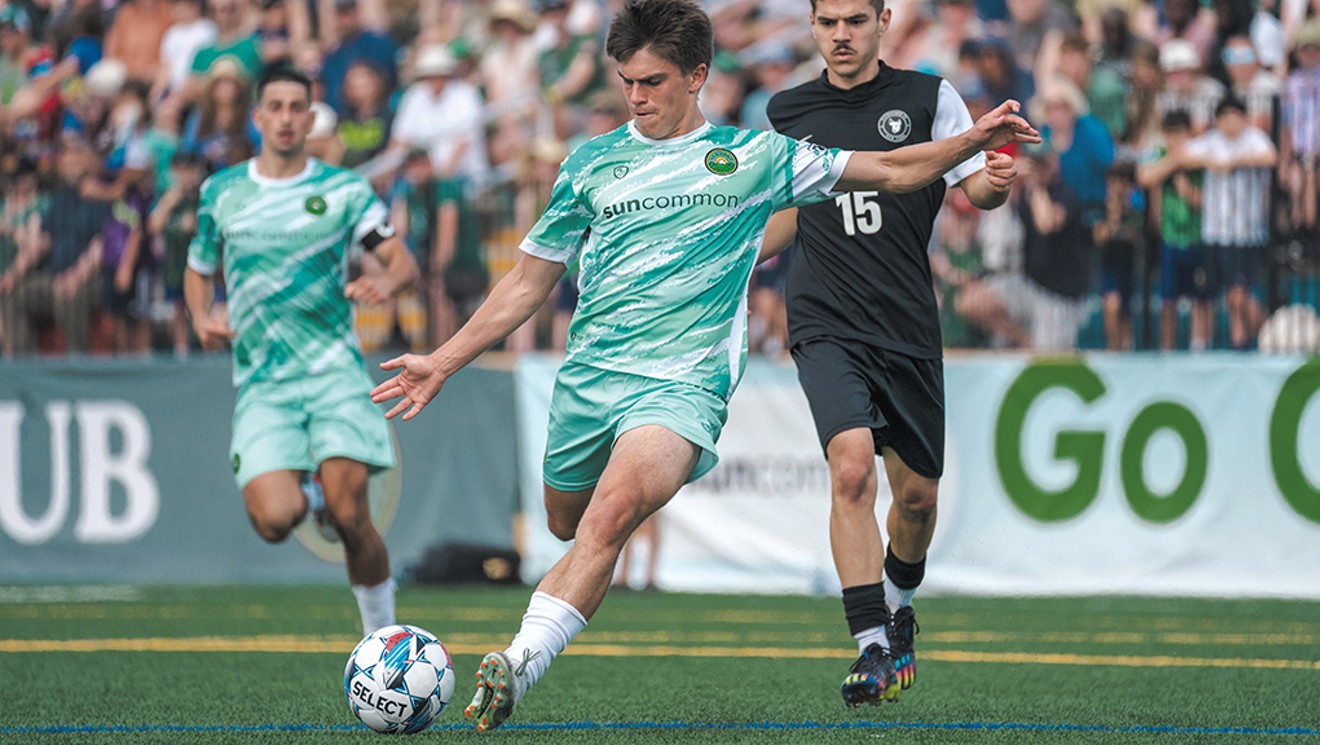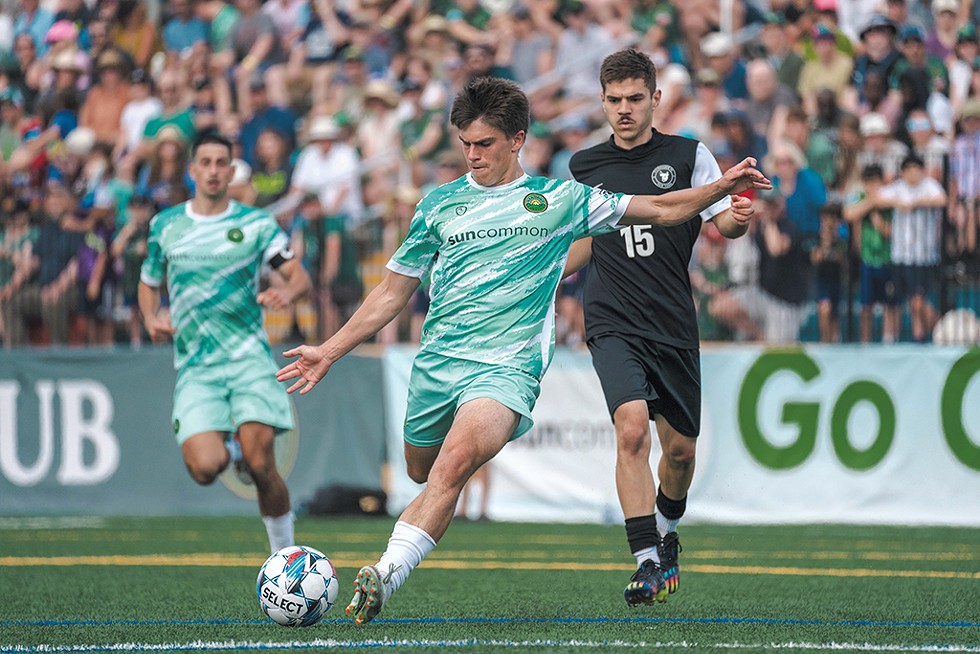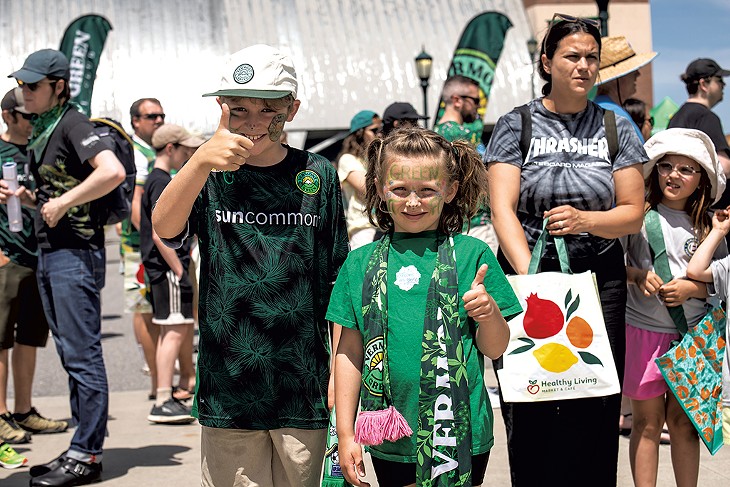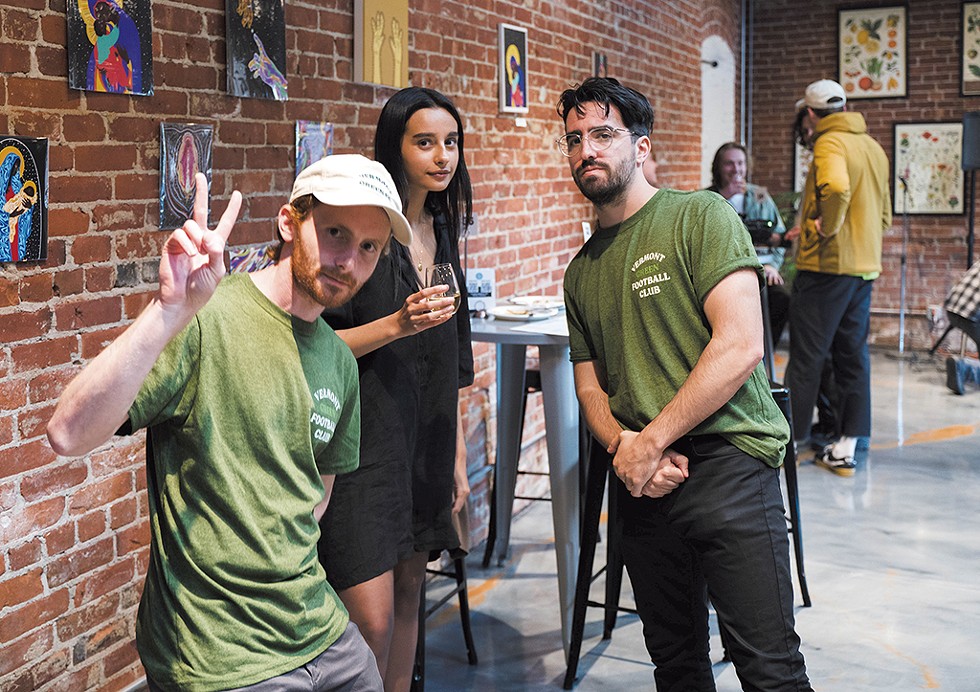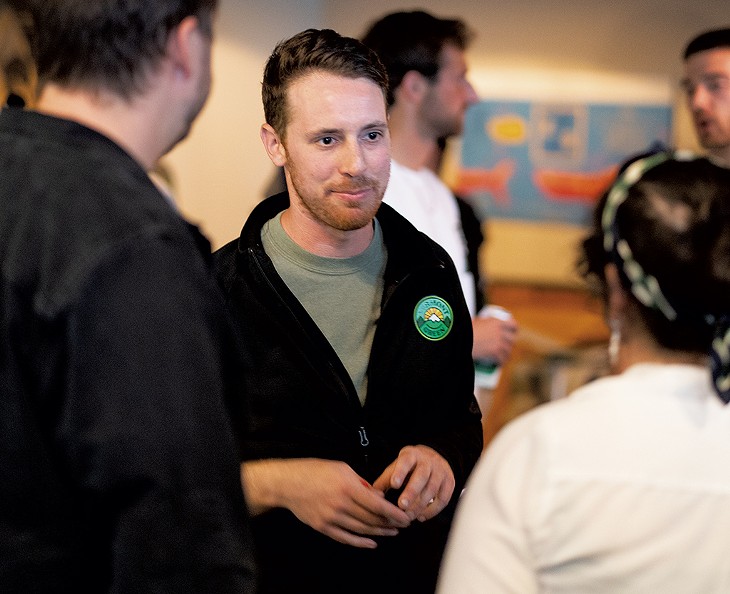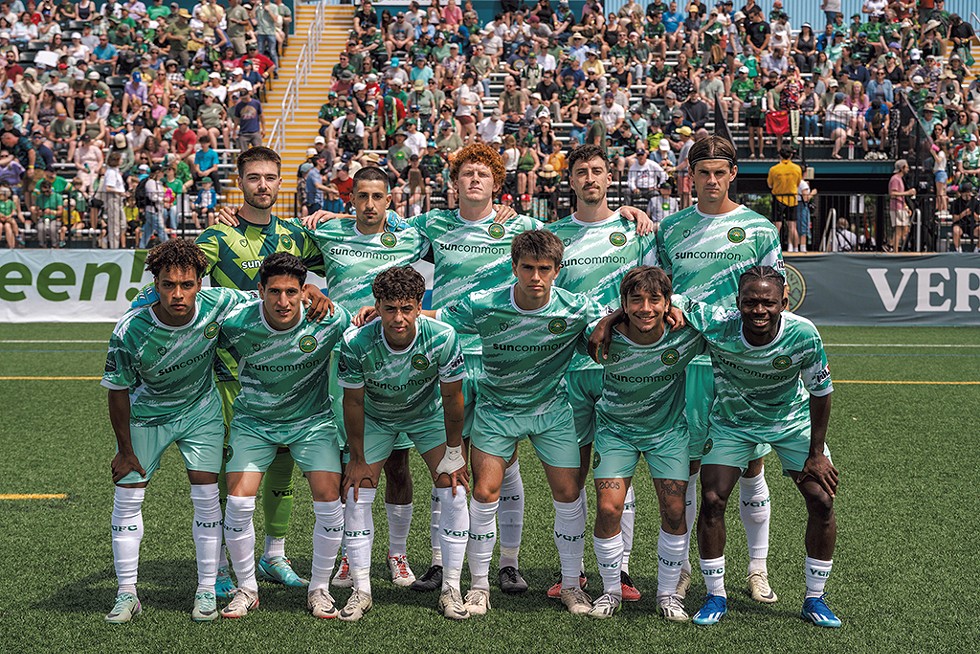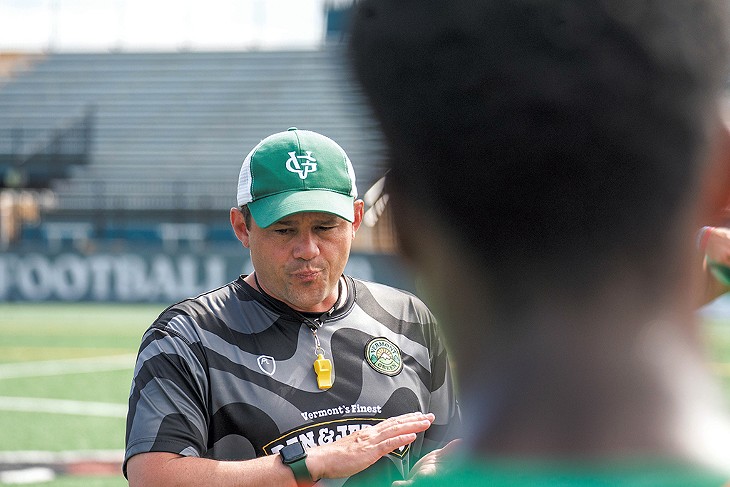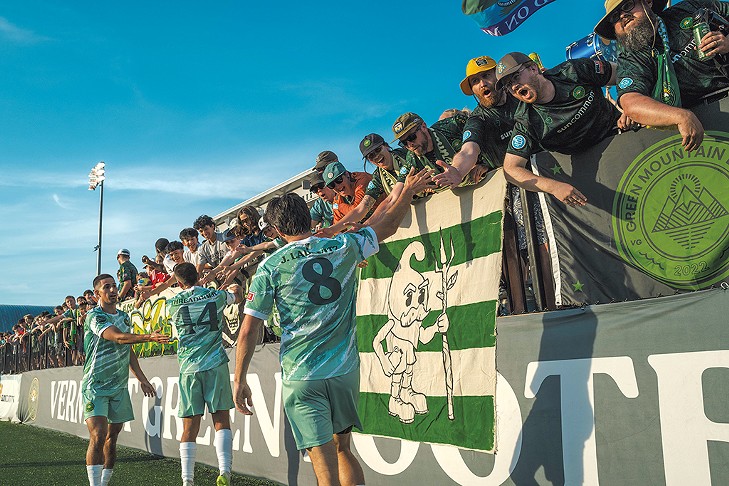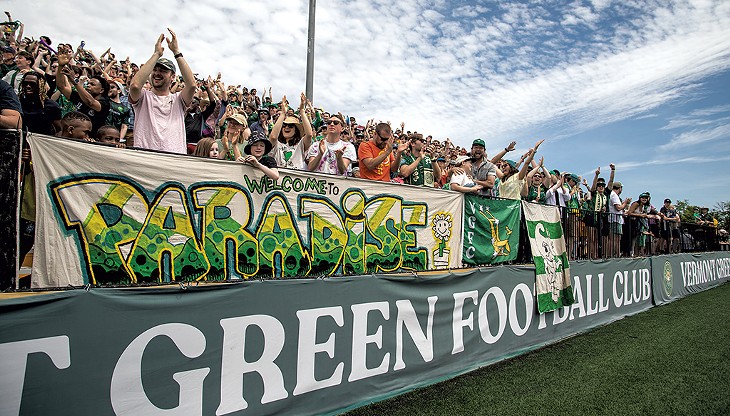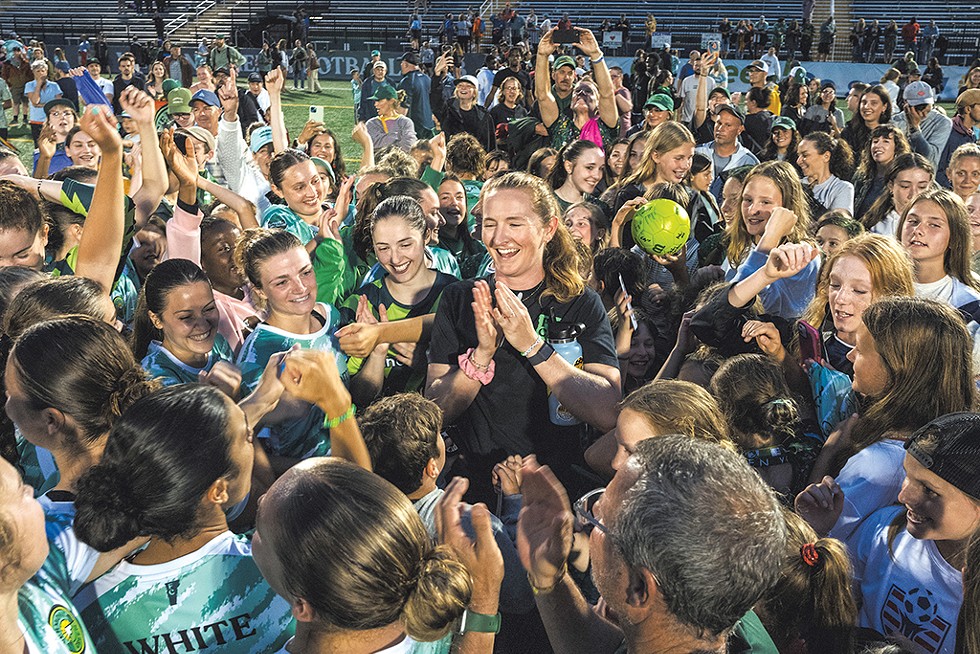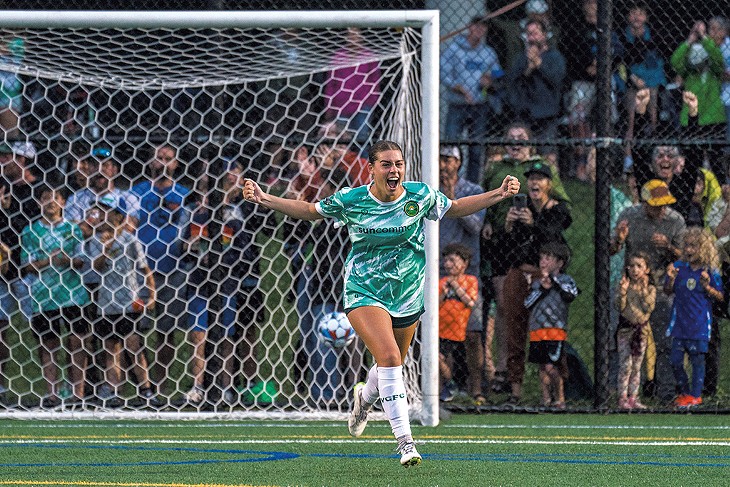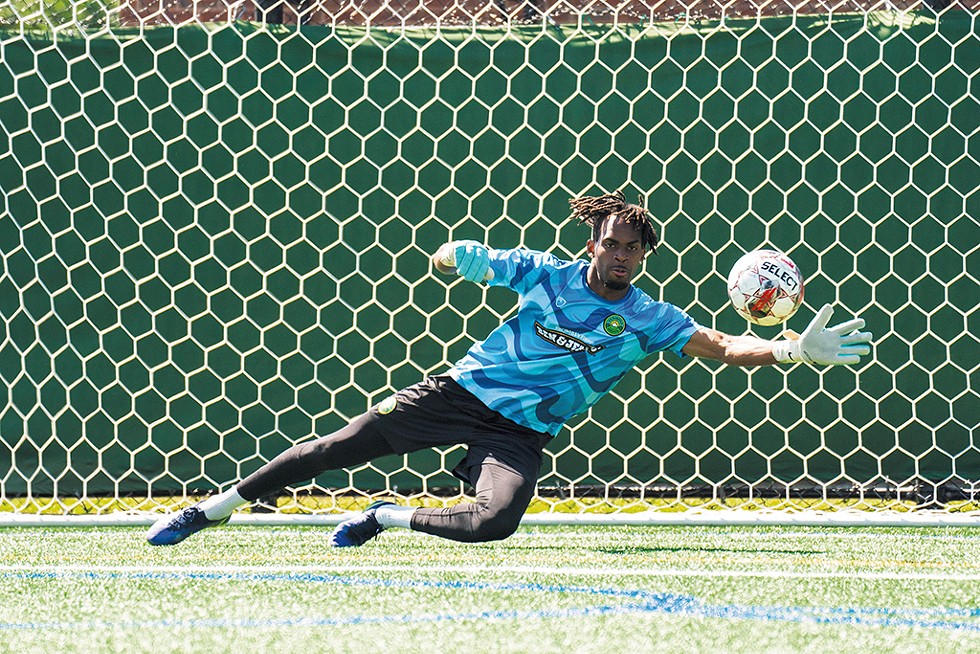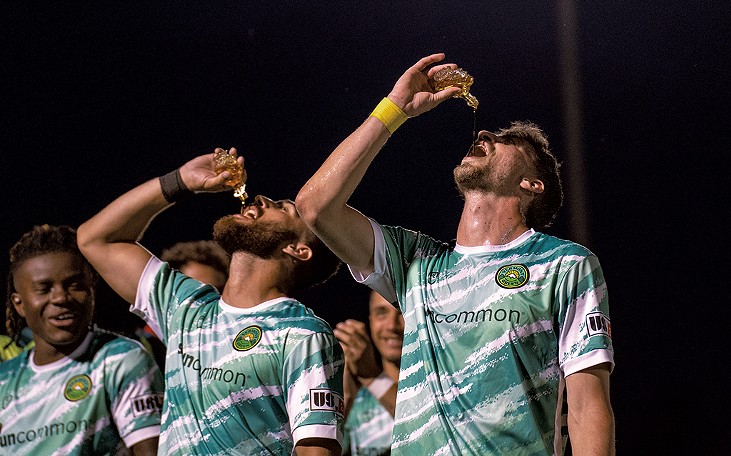Milo Littwin’s eyes widened as he took in the subtle shades of green and white on the soccer jersey. Behind the merchandise table, mercifully sheltered from the sun of a sweltering early June day, a college-aged employee handed over the object of the young boy’s desire: a 2024 Vermont Green FC home jersey. At $79, this was no small treat.
“You want to put it on now?” Tyler Littwin asked his son, who is 8. Milo stood beside his 7-year-old brother, Oscar, who was also getting a new jersey.
Both boys nodded and pulled off their 2023 Green uniforms, eager to put on the fresh threads before the start of the game. Behind them, Virtue Field, the University of Vermont soccer stadium that doubles as the Green’s home base, was already roaring with the sound of 2,500 people filling the metal bleachers for the sold-out season opener. Throngs of fans were lined up at the food trucks and beer tent just outside the pitch: packs of college kids, young professionals and retirees, most decked out in team merchandise.
“That really hits me sometimes, that their sporting life starts with this team,” Littwin said as he led the boys toward the concourse. “I didn’t have that growing up, and I don’t think too many American kids my age did either – a soccer team in their own town.”
Most games, the Littwins sit near the team’s most fanatical supporters, the Green Mountain Bhoys, who, for 90 minutes, chant, hit drums and wave flags; on one memorable occasion, they lit flares. The intensity of their fandom is only augmented by the brevity of the season: The Green play for just over a month and a half.
Beneath the stands, a small-sided pickup game of soccer broke out among some kids. Milo looked to his father in a silent plea to jump in, but his dad was all business: new jerseys for the kids, hot dogs and drinks, secure seats, kickoff.
“For me, as an adult who has loved this game his whole life, I try not to lose perspective on just how special this all is,” Littwin said. “Nothing about the Green is ordinary.”
Home-fan bias aside, Littwin has a point. The Vermont Green had their first season in 2022, after four friends — Matthew Wolff, Patrick Infurna, Sam Glickman and Keil Corey — dreamed up a semipro soccer team in Burlington. The founders wanted the Green to embody their values, namely environmental and social justice — not exactly typical concerns among team owners.
Now in their third season, the Green have surpassed just about every expectation the owners had for their baby. The club, which plays in United Soccer League Two, a few notches below Major League Soccer, has posted winning records every season and even qualified for the illustrious U.S. Open Cup. Three members of the 2023 squad were drafted into Major League Soccer, a sign of the Green’s ability to prepare players for a professional career. The team has partnered with eco-friendly companies to make its merchandise and secured local sponsors, including Seventh Generation and now-beleaguered SunCommon, that share its values.
Yet the Green’s most impressive achievement might be the team’s robust — and growing — connection with the Burlington community. In a city never exactly known as a sports hotbed, the Green have routinely sold out home games and inked deals with local TV networks to broadcast matches. A Burlington cannabis dispensary sells “Vermont Greens” joints, and the team has collaborated with local craft breweries such as Zero Gravity and Burlington Beer for signature beers. The team’s hats and jerseys, with slick designs that rival professional teams, are common sights in and around Burlington.
Eager to capitalize on the team’s rapid rise, the founders are dreaming of building a stadium of their own. And a women’s exhibition game over the weekend drew more than 2,500 people, a turnout that has the owners weighing whether the Queen City could support two teams.
“That first season, it was all about that question of, ‘Can we do this?'” Infurna said. “Now, we feel confident that this club could — and should — outlive us. We want to build a community asset that is rooted and here in perpetuity.”
Getting the Green Light
Despite its status as the world’s most popular sport, soccer only started gaining ground with fans in the United States within the past 10 or 15 years. Before that, Green cofounder Infurna recalled, the sport “used to be almost like punk.”
“It was for rejects or people who didn’t feel any connection with the big American sports,” Infurna said. “The people who loved it banded together in this fierce sort of community, and that’s what I fell in love with soccer for.”
Infurna, 32, was born in New Jersey but grew up outside Rutland. With no way to watch soccer on TV or a local team to call his own, he channeled his passion for fostering a kind of outcast community into booking punk shows at local grange halls and American Legion posts.
After graduating from Castleton University in 2011, Infurna embarked on a career in soccer, working as a social media producer and manager for international clubs, including German Bundesliga teams Hertha BSC and Eintracht Frankfurt, his current employer.
“To me, the American sports model is to treat fans like nothing other than potential consumers,” Infurna said. “I’ve always craved a sense of community over that sort of ultra-corporate experience.”
Unbeknownst to Infurna, the opportunity to turn that desire into a tangible reality began taking shape in 2020. During the COVID-19 lockdown, a friend of his from Burlington, Keil Corey, was furiously exchanging texts about launching a semiprofessional soccer team with two former soccer teammates from Skidmore College, Matt Wolff and Sam Glickman.
A graphic designer and art director, Wolff designed kits for MLS teams, and he created the uniform the French Men’s National Team wore when they won the 2018 World Cup. Wolff had been reading about the Forest Green Rovers, an English soccer club that focuses on environmental issues. It became a completely vegan club in 2015 and launched initiatives to cut carbon emissions. A light bulb went off in Wolff’s head: What if he could help create a team in his own country that championed environmental causes? He reached out to Corey and Glickman to workshop what first seemed, according to Glickman, like a “pie-in-the-sky fantasy.”
“It all started as a very hypothetical sort of thing,” Wolff explained. “We started texting, then we started talking over Zoom, and suddenly it’s like, wait — Are we seriously going to do this?”
Corey was working in Vermont as a consultant, helping businesses adopt environmentally sustainable strategies. The prospect of starting a soccer club based on environmental and social activism intrigued him.
“I started wondering what a small club dedicated to these sorts of tenets might accomplish,” Corey said. “Could we create a viable blueprint for a sports team to deal with climate change and systemic racism?”
Glickman, who was working at San Francisco-based payment app Stripe, came aboard as the finance guy. Corey brought his friend Infurna, with his extensive soccer media experience, into the core group. None of the four men had ever started a business, much less launched a sports franchise, but they were determined to give it a shot.
Wolff, who had previously worked for Nike, had advised USL teams on uniform design. His connections helped expedite the process of starting a franchise. He, Corey, Glickman and Infurna pooled their own money to pay the USL’s $75,000 franchise fee and signed a multiyear deal with UVM to use Virtue Field. (The founders wouldn’t disclose how much they pay UVM to lease the stadium, but Glickman noted that it’s one of their biggest expenses.)
That was the easy part.
The Queen City has never been a soccer hub. The last semipro men’s soccer team in the area, the Vermont Voltage, played in St. Albans for 15 years before it folded in 2014. In spite of its longevity, the club never established any kind of foothold with fans in the community.
“The vibe around the Voltage was basically for little kids,” former Sports Illustrated writer and Cornwall resident Alex Wolff — no relation to Matthew —said. “The team existed essentially as an offshoot of the youth soccer camps the program ran.”
The Voltage also didn’t project an image of social consciousness like the Green’s. Through canny marketing and aligning themselves with the right brands, the Green’s founders aimed to win over progressive-minded Burlingtonians. The team brought on SunCommon as its primary sponsor and eventually attracted other Green Mountain companies, such as Ben & Jerry’s, who shared the ideal Green fan’s values. Using Matthew Wolff’s expertise, the founders created sleek, millennial-core designs for their websites and jerseys.
Earlier this month, iSun, the parent company of SunCommon, filed for bankruptcy and laid off dozens of employees — including Madeline Hammer, who first connected the company and the team. Hammer, the director of marketing at SunCommon at the time of the Green’s founding, was instrumental in convincing the company’s executives to sponsor the team.
“Their pitch deck was professional,” Hammer said. “Obviously, the branding was stunning, and the club’s climate and social justice mission was a huge factor. Everything was thoughtfully curated, and it was clear the guys were bringing something different to the Vermont sporting community.”
Since that first season, the company has paid a large sum — Glickman won’t say how much — to have “SunCommon” splashed upon the game-day jerseys. In the wake of iSun’s bankruptcy, SunCommon has paid its bills, Glickman said. Whether its logo will be on the jerseys next year is an open question.
Field of Dreams
The score was 0-0 in the first half of a May 25 match at Virtue Field between the Green and Pleasant Valley, N.Y.’s Pathfinder FC, and the sold-out stadium was roiling with anticipation. Green forward Zach Zengue’s corner kick zipped into the penalty box, a fast, curling pass. Center-back Reid Fisher rose above the fray to flick the ball toward the far post, and forward Yaniv Bazini smashed a volley past the Pathfinder goalkeeper, sending the crowd into hysterics.
Fisher and Bazini ran toward the bleachers, throwing their arms around each other as the stadium erupted with the roar of 2,000-plus fans. From somewhere beneath the stands, Glickman sprinted out and bellowed his support from the edge of the touchline.
Most of the Green players, including Zengue, Fisher and Bazini, are college athletes, which is typical for USL League Two teams. The players aren’t paid, due to NCAA regulations; instead, the team finds them local host families during the 14-game season, plus playoffs.
Many of the league’s 74 teams hail from midsize cities, such as Rochester, N.Y., Flint, Mich., and Des Moines, Iowa. The defending champions, Ballard FC, play in Seattle. During the regular season, the Green play eight different teams, all of which are within a 5-hour bus ride.
Not everything goes to plan. A recent home match against AC Connecticut was delayed for more than an hour after Connecticut’s bus broke down on the drive up to Vermont.
The Green have suffered their own bus-related indignities. During their first season, when the founders were pinching every penny, the team booked an old yellow school bus — the kind most American school kids grow up loathing, where every bump on the road feels like a tackle and air-conditioning is a crapshoot — to transport them to away matches.
“I hated that bus so much,” said midfielder and captain Daniel Pacella, who has been on the team since the first season. “It was bad enough on the way to the game, but on the way back, after you just played 90 minutes? And no bathroom? Rough.”
The players voiced their displeasure. The team now rides in a charter bus.
Head coach Adam Pfeifer has been with the team since day one. Formerly the coach of the men’s team at Norwich University, he’s now a full-time employee of the Green. Much of his work involves recruiting players.
“We sell a lot of our recruits on the fact that they’ll play some top-level soccer during their summers,” said Pfeifer, who played college ball at Boston College and won two USL championships with the Cape Cod Crusaders in 2002 and 2003. Another selling point, Pacella said, is “the incredible atmosphere at our home games.”
That atmosphere was apparent back in March — in Vermont! — when the team hosted a game in the U.S. Open Cup. The tournament, the oldest of its kind in the country, is a massive, geographically sprawling affair, in which the lowest-tier clubs can face professional foes, even an MLS team.
For a new club in Vermont, qualifying alone was an achievement. But the Green went on, in thrilling fashion, to eliminate Lexington SC, a professional team that featured a striker in its starting lineup who used to play with Tottenham Hotspur in the English Premier League. U.S. Sen. Bernie Sanders (I-Vt.) even tweeted a message of congratulations to the Green.
“This is a really strong team,” Pfeifer said. “A lot of the guys on the team in year one wouldn’t have a chance of making this team now. As our reputation grows and we can recruit higher-caliber players, I think the ceiling just goes up and up.”
One of Pfeifer’s first recruits was Pacella, who joined in the inaugural season and has returned each year. Originally from Montréal, Pacella, 24, came to Burlington to play soccer at UVM and has lived in Vermont for four years. He’s transferring to San Diego State University in the fall, but he said his time playing with the Green will stay with him forever.
“I’ve never experienced anything like this atmosphere in my career,” Pacella said. “It’s kind of unreal sometimes to see all the people here. You go to an away game, and you’re like, Damn, there’s no one here!”
Culture Club
There can’t be too many teams in American sports that start games with a land acknowledgement. But Tom Proctor announces over the Virtue Field public address stadium system before each kickoff that the games are played on Abenaki land.
“I love that he’s British,” gushed a fan in the stands at the 2024 season opener. “I know that’s silly, but I don’t know — it just lends some authenticity to it, you know?”
After seeing an online post from the club seeking a game-day announcer for its first season, Proctor, originally from Manchester, England, decided to throw his hat in the ring. “I was going to buy a season ticket anyway,” Proctor said. “Cheap bastard that I am, I thought I might as well try my hand at football announcing and save myself some money.”
A housing justice organizer by day who also hosts “Rocket Shop,” a local music show on Big Heavy World, Proctor was initially skeptical of the club’s environmental and social justice mission. He thought it was a gimmick.
“After I talked with the founders, it became very apparent that was not the case whatsoever,” Proctor recalled. When he saw that the club was donating portions of its revenue to environmental nonprofits and aligning with coalitions such as the Anti Racist Soccer Club, he was sold.
“They’re building a real, bona fide culture with this team, man,” he said. “You can see it progressing with every match.”
That culture was on full display before the first home match of the third season. An hour before kickoff, the parking lot outside UVM’s Gutterson Fieldhouse, across from Virtue Field, was already filling up. The smell of grilling food wafted through the air, and a group of supporters wearing T-shirts with their local union designations cavorted over beers. They had come for the Green’s Labor Night, where the team celebrated Burlington’s working class with a halftime spotlight in the center of the pitch.
Nearby, the Green Mountain Bhoys, outfitted in Wolff-designed jerseys and Green-branded scarves, gathered around a pavilion. They waved homemade flags as they warmed up their singing voices, breaking into occasional chants of VER-MONT GREEN, VER-MONT GREEN! After the chanting died down, several of the Bhoys went back to planning a weekly Dungeons & Dragons game and drinking $11 beers.
Littwin founded the Bhoys, a portmanteau of Vermont’s Revolutionary War militia and the famously devoted Glasgow Celtic FC supporters. In the Green’s first season, Littwin, a graphic designer, started making game-day posters and connecting with other fans through social media. Chants were written, banners printed, podcasts launched; as the wins kept piling up on the field, the supporters’ section of the stands kept growing.
“Post-pandemic, I think a lot of people lost their third spaces,” Littwin said. “They either are at work or at home, or those two things are one and the same. So to see this whole ecosystem that’s sprung out of the Green and to make the kind of friendships I have, I’m just super grateful.”
Inside the stadium, the Bhoys are irrepressible. Casual sports fans who find themselves near the group are in for a jarring discovery: Somewhere between nerd and jock cultures, there’s a strange in-between zone of fandom where grown adults scream at opposing team players about their perceived dating habits.
“Number six ghosted his last girlfriend!” one supporter bellowed at a recent game, drawing a chorus of laughs from the surrounding fans.
“I heard Pathfinder FC stands for fart committee!” came a slightly less inspired, though equally well-received, insult.
The Green Mountain Bhoys, and the sellout crowds at Virtue Field, make the Green unique in their league, according to Infurna. Indeed, the Green’s average 2023 season attendance of 2,200 made it the second-best-supported club of all 74 USL Two teams, behind only a squad that plays in San Francisco.
“I think our atmosphere has set the tone and raised the bar,” Infurna said. “Teams come here and see our crowd and get so hyped they play us like it’s a cup final, which is kind of annoying, but also a sign of respect.”
Fans who can’t make it to games can now watch the Green on local TV. The team struck a deal this season with WCAX-TV to broadcast matches on the network’s sister channel, WYCI. The station’s vice president and general manager, Jay Barton, was all in after having coffee with Infurna in the offseason.
“Their enthusiasm is absolutely contagious. I came away feeling like, Whatever I can do to help this project, I’m going to do it,” Barton said.
National media have also started to take notice of the Green. The team has been featured in the Guardian and on the BBC and drooled over by popular soccer podcasts such as “Men in Blazers,” which visited Burlington last year to record a live show.
“Whenever I see anything [the Green] do, I want to jump through the screen and be there,” said “Men in Blazers” cofounder and host Roger Bennett.
Alex Wolff, the former Sports Illustrated writer, said he’s been blown away by the team’s fan culture.
“Most soccer in America at this level is essentially a glorified youth soccer camp experience,” he said. “The Green is a fan experience, and you can’t just invent that on a drafting table. You have to create it organically.”
Wolff would know. In 2006, he launched the Vermont Frost Heaves, the state’s first, and only, professional basketball team. The team played in Barre and Burlington until it folded in 2011; Wolff documented it all in a Sports Illustrated article.
The Frost Heaves enjoyed early success, even winning the 2007 American Basketball Association Championship, and created a close bond with their fans. But splitting home games between cities — and the economic difficulties of maintaining a team of paid professional athletes — proved untenable.
Wolff noted that the Green have figured out ways around many of the problems that plagued his basketball passion project. He’s confident the team can continue growing.
“Even if what they’re doing is on a small scale in the sports world, it’s incredibly exciting,” Wolff said. “For a team with their social mission to have success, what might that say to bigger teams? What might be accomplished if those bigger teams took up the Green’s methods? Just look at the connection between the team and its culture — it’s what every club wants.”
Tomorrow’s Green
An air of excitement ran through the players as they finished morning training on a recent Thursday. Pfeifer had mostly taken it easy on them after a tough loss in New Hampshire the night before.
Yet the team was all smiles as they gathered around a special guest.
“I’m pretty sure this is the best player to ever step foot on Virtue Field,” Pfeifer said as he introduced Sam Mewis, a former star player for the 2019 World Cup-winning U.S. Women’s National Team. The Green had tapped her to coach a women’s exhibition game, a sort of trial run of one of the founders’ long-term goals: fielding a women’s soccer team.
Wearing a Green FC training jersey, Mewis greeted the squad. The young men, eager for even a modicum of the success Mewis enjoyed throughout her career, soon peppered her with questions about the World Cup and playing in the 2021 Summer Olympics.
Attracting Mewis as a coach — and fielding a women’s team for a sold-out exhibition game — is a testament to how far the Green have come in such a short time, and an indicator of what might be on the horizon. Women make up 51 percent of America’s soccer fans, according to a 2022 study by Sports Innovation Lab. The most recent Women’s World Cup, in 2023, averaged 4.3 million viewers in the U.S. for each match. When it comes to soccer in America, the future is absolutely female.
“Starting the women’s team is a huge priority for us,” Matthew Wolff said. “If we’re going to be the club for this area, we have to. There’s such a hunger for women to both play in the USL and to be able to watch women’s soccer.”
As luck would have it, Mewis, who recently retired from playing soccer, just moved to town.
“My husband and I visited the area last year and fell in love,” Mewis said. She was standing on the sidelines of Virtue Field, watching the team train with the kind of longing only a former player with surgically repaired knees knows.
Mewis and her husband bought a house in Colchester last February. She’d been working in sports media since retiring from soccer, she said, and she was already aware of the Green’s remarkable ascent.
“What the Green are doing, it could really turn into something special,” Mewis said. “Not just for the community here, but for the women’s game in general. And to be a part of this club’s history now is a very cool feeling.”
Mewis led the Green out against Canadian women’s team FC Laval, securing a win on penalty kicks in front of a stadium that had been sold out weeks in advance.
Extra time
The Green’s founders have additional bold aspirations, from fielding a youth program to the “ultimate dream,” in Glickman’s words, of having their own dedicated stadium. While UVM’s field has mostly worked out for them, long food and beer lines have been persistent issues.
Until the Green have their own place, the team is bound by UVM’s contract with food service giant Sodexo. After hearing complaints from fans about the long lines and limited options, Glickman negotiated with UVM to allow food trucks outside the stadium to accommodate their growing fan base.
“It’s challenging to work with a large entity like UVM,” Glickman admitted. “But we’ve been able to work out a relationship with them to do whatever we need, because we literally wouldn’t exist without it.”
In spite of such challenges, the Green have already made good on some of their environmental commitments. The team is working with the Science Based Targets initiative to monitor emissions, with the goal of eliminating its carbon footprint in the near future. Jerseys are made of recycled plastic in solar-powered factories. According to Glickman, the team is picky about its sponsors.
“We’ve definitely had to turn away partners,” Glickman said. “They’ve been nice offers that certainly would help the club financially, but they’re not mission aligned. If you’re attached to the oil or gas industry, well, that’s not really part of who we are.”
Finding big green companies in little Vermont is no easy feat — and with the parent company of the team’s biggest sponsor facing bankruptcy, the Green are on the hunt for new sources of financial support.
The founders say the loss of their main sponsor isn’t enough to sink the team, but they acknowledge that margins are tight. Even though tickets sell by the thousands for $15 a pop and jerseys bring in about $80 each, that revenue is getting pumped right back into the team, they say.
“There’s no big investor or sack of money we’re working from,” Infurna said. “Bringing in investors could certainly alleviate those types of problems, but once you take someone’s money, you have to answer to them.”
Of the four, only Glickman pulls a paycheck as a full-time employee of the Green. Infurna still works for Eintracht Frankfurt; Wolff still has freelance design work; and Corey, who moved to Montréal last year, has stepped back from his role in the Green.
But none of the founders is complaining about the long hours and minimal pay.
“I still get this feeling every week, like, I can’t believe this is happening,” Infurna said. “This isn’t our little experiment any more. It’s a real, living thing that doesn’t just belong to us. It belongs to the fans and the ball boys and the players and everyone who loves this club.”
Earlier this month, as fans poured into the stadium before a home game against AC Connecticut, they seemed as excited by the club’s existence as the game itself.
“I didn’t know that much about soccer before a few years ago,” said Bridget, a 29-year-old social worker from Essex. She was sporting a 2023 away jersey and carrying two beers as she went to find a seat before kickoff. “But it just doesn’t feel like this is typical. These are next-level vibes.”
The vibes carried over onto the pitch as the Green routed their divisional foes 7-0, behind a hat trick from forward Bazini. Long after the final whistle, the team stayed on the field to celebrate with the fans, chugging tiny containers of maple syrup.
